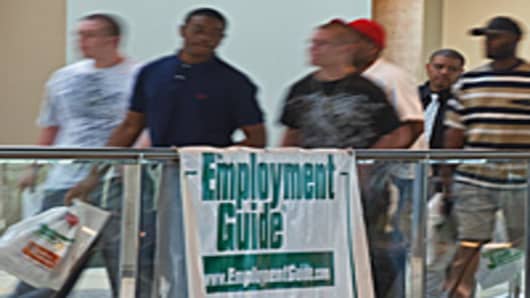If you think the jobs situation has become pretty hopeless, you're not alone. Roughly 1.1 million workers have given up hope of finding employment.
The staggering level of "discouraged workers" as the government calls them has swelled to historic proportions in 2010, past the million barrier for the first time since the Bureau of Labor Statistics has been tracking the number.
Though a bit off its all-time high of 1.2 million recorded in February, the metric stands as perhaps the most daunting statistic of last Friday's gloomy jobs report, which showed that almost all the new employment is coming from temporary government Census jobs and not the kind that will sustain an economy.
"The fact that people are sitting down indicates just how bad the market is for some categories of people," says Peter Morici, professor at the University of Maryland's Smith School of Business and the former chief economist at the US International Trade Commission.
That picture is unlikely to get any better, particularly in terms of the headline unemployment rate number on which most people focus. That figure actually dropped from 9.9 percent to 9.7 percent in May, but was as much a reflection that many people simply dropped out of the jobs market and are no longer counted as unemployed.
Even if those who have quit searching come back to the market, that will only keep the headline number high as the labor force increases.
"Now you're going to have the woodwork effect," Morici says. "All the people who were discouraged will be coming out of the woodwork to find jobs."
As the headline number has dropped from 10.1 percent in October 2009, the number of discouraged workers has jumped 34 percent, from 808,000 to 1.08 million.
The decline in active job-seekers, in fact, may be helping pad the employment picture at least on the surface.
"If it weren't for the plunge in the labor force, the US unemployment rate would have climbed to 10% in May," Gluskin Sheff chief economist David Rosenberg says in his morning note Monday. "[T]he household survey actually flagged a 35,000 outright decline in employment last month."
And the growth in discouraged workers—technically defined as those who haven't looked for work in four weeks—could well stay high for the foreseeable future.
The long-term unemployed—those who haven't worked for at least 27 weeks, or more than half a year—remains mired at 6.8 million, a number that accounts for 46 percent of the total jobless figure.
Ramifications of the credit crisis and the ensuing efforts companies made at doing more with less have helped depress employment as well. Company productivity rose 2.8 percent in the first quarter.
"We don't expect any substantial improvement to the labor situation at all," says Richard Hastings, macro and consumer strategist at Global Hunter Securities in Newport Beach, Calif. "Companies just don't need as much labor to drive as much output from technology and machinery. If you're in the wrong industry and you don't have a track record in the right skills in other industries, you're going to be a long-term stat."
Looking For Some Bright Spots
Some economists also worry that the government is providing a disincentive to work by extending unemployment benefits. It's a Catch-22 in which the government is hoping to help the long-term unemployed that could backfire as people become less interested in finding work the longer they remain idle.
"What's keeping people out of the job market is they're giving extended benefits," says Doug Roberts, chief investment strategist at Channel Capital Research. "A lot of people, especially those who are older, are figuring, 'I'll keep my unemployment benefits for as long as I can get them until I can figure out what to do.'"
Among the few positive notes to come out of the jobs report last week was a decline in what some refer to as the "real" unemployment rate, the calculation that counts all the jobless and not merely those who fit into the government's counting mechanism.
That number—technically referred to as the U-6 figure—actually dropped to 16.1 percent, though Rosenberg generally questions the government data because of a reliance on its "birth-death" model.
And some analysts also say that the stock market, at least, can continue to grow even in the face of such daunting unemployment trends.
BofA-Merrill Lynch Global Research said it is sticking to its projections of 275,000 monthly job gains for the fourth quarter. That estimate comes even though the firm says the monthly figures could turn negative later this summer when the Census hiring stops.
"Recoveries do not move in a straight line and NO, this is not a sign we are about to double-dip," Ethan Harris, BofA-Merrill's head of developed economics research, told clients. "Double-dips happen when there is a policy mistake, which we do not expect."
Morici, for one, takes issue with the notion that public policy is not jeopardizing the jobs market. A harsh critic of the Obama administration, he says the $780 billion stimulus was squandered on projects that don't help sustain industry and manufacturing and thus will not provide lasting economic relief.
"By and large they don't have a grasp of the scope of the problems, and we're not creating that much demand for labor," he says. "They're not putting the stimulus in the right places. This administration is really being run like a Junior Achievement project."
Yet companies, if not their potential workers, could yet benefit and in turn pass savings along to investors.
"It's not going to change," Hastings said of the jobs picture. "Some people believe that it's terribly detrimental (to the stock market) and we don't. Companies can drive earnings growth with less labor."




